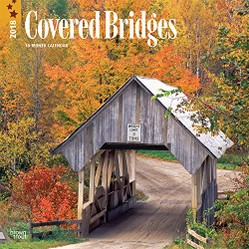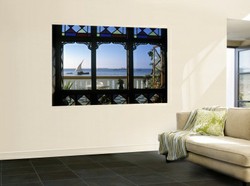Covered bridges were once common, especially in New England. Many still survive today. This is amazing since they were made of wood, and placed in a moist environment over rivers and streams. One would think that many of them might have deteriorated. Then, wood is subject to fire, and lightning could easily take one out during any thunderstorm, especially if the surrounding land has nothing higher than the bridge.
Today, they are appreciated for their beauty, and can immediately take us back in time to another period. They have thus become true treasures, and have found many who appreciate them.
What functions might covered bridges have served? Well, one may well have been to keep horses from becoming wary of crossing the bridge. The horse would not feel elevated over the water below. Another advantage of having a bridge covered could have been to give travelers a place to rest out of the hot sun, or away from the bitter cold wind, rain, or snow. Then, on icy wood a surface could become slippery in cold weather due to icing. There is a reduced likelihood of slipping if the bridge is covered, because ice is less likely to form, and falling sleet or snow is stopped by the bridge’s roof.
Intro image: This is an Amazon image allowed by the affiliate program.













 Christmas on Zazzleon 10/21/2025
Christmas on Zazzleon 10/21/2025
 The Linear Equation and Related Equations and Inequalitieson 08/15/2024
The Linear Equation and Related Equations and Inequalitieson 08/15/2024
 Understanding Calculus: A Simplified Approach to Derivativeson 08/05/2024
Understanding Calculus: A Simplified Approach to Derivativeson 08/05/2024
 Limits: Vital Building Blocks of Calculuson 08/01/2024
Limits: Vital Building Blocks of Calculuson 08/01/2024




Comments
There was also a hearth tax, a tax on how many hearths people had.
If you google for "Ambleside; the house on the bridge " , you will find it .
BSG
If you do get to England , perhaps you could ask Mari , Paul, Frank and the rest of us where to visit before you travel. We all seem to know the very best places north and south, off the beaten track.
Frank, the local story is that the wealthy family built it as a summer house. This is unlikely as it is so tiny that the upper classes wouldn't have countenanced it.
There were several taxes on houses , a way for the English governments to wring the public dry. people could be taxed on how many windows they had and this resulted in the bricking over of several windows. Look at old manors and you will see several examples of bricked up windows. This was to avoid tax.
Strangely enough I was once outside of Chicago and on a highway. I looked up and was passing under a restaurant, so I can easily believe a house could be on a bridge.
I would like to get to England, but before I could ever think of that I would have to retire. I am hoping to get to Canada which is easier for me, but not in the winter. Yes, there are many places I would enjoy seeing.
I cannot see how parliament could conceive of houses not being built on land or expressing this in law, and anyway,if the authorities wanted to tax the house, they would have got the courts to decide on the issue. However,the fact remains that the house is quite a curiosity.
I always believed that the house in Ambleside was built on a bridge to avoid the new British government tax at the time which exempted houses from tax if they weren't built on land. But I have no idea as to the true reason it is built on a bridge.
You ought to visit Ambleside in Cumbria, where there is a tiny house built on a bridge. The tale is that the builder was told that he could construct a house, but could have no land,so he erected a bridge for his very tiny dwelling to stand on.
Thanks.
One does not have to actually live near the covered bridges to appreciate them. A vacation would make them special as a remembrance. Then, there are the images. Thanks for the comment.
I do not live out East where most of the covered bridges are, but we do have a few here in Colorado and I really like them.